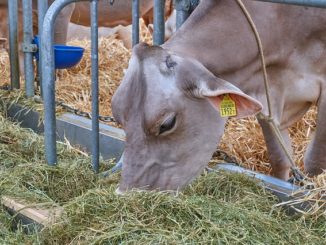Introduction
Ruminants are one of the most successful groups of herbivorous mammals on the planet, with around 200 species represented by approximately 75 million wild and 3.5 billion domesticated individuals worldwide. Humans domesticated these animals in the Neolithic era (Ajmone-Marsan et al., 2010) and have been farming them ever since for the production and consumption of animal protein in the form of meat and milk. These animals also emit methane, a highly potent greenhouse gas, to the atmosphere and are considered to be responsible for a considerable portion of its emission because of anthropogenic activities. Methane is the second most important greenhouse gas after carbon dioxide due to its 25 times higher global warming potential.
Under Indian feeding situations, where poor quality roughages forms major constituent of animal diet, production of acetate is more which contributes to higher methane production and also leads to poor productivity of animals (Garg et al., 2012). Imbalanced feeding results in low milk production, poor growth and reproduction, shorter lactation length, longer calving intervals and excessive amounts of pollutants released into the environment (FAO, 2012). Animals fed imbalanced ration produce more methane per unit of dry matter intake due to lower microbial protein production and higher acetate production. Therefore, increasing animal productivity by feeding balanced ration will also result in lesser polluted environment.
Rumen Archaeal Microbiome and Metagenomics Technonolgies
Rumen, a four chambered stomach, is bestowed with a highly diverse and efficient microbial world, which provides the unique characteristics to the ruminants. Being bacteria most prevalent, there are also presence of protozoa, fungi, archaea and bacteriophages. Methanogens, the methane-forming archaea, are among those that metabolize hydrogen formed by some fermentative microbes to form methane. Methanogens are known to colonize protozoa, and this mutualistic relationship is believed to enhance methane formation in the rumen.
Some strains of archaea, mostly methanogens, were isolated and characterized biochemically and physiologically decades ago. As with the rumen bacteria, most (>98%) of the archaeal 16S rRNA gene sequences were from uncultured methanogens; however, species richness and diversity of rumen methanogens are much lower than those indices describing bacteria. The 16S rRNA gene is the most widely used target for gene surveys, and a number of primers and probes have been developed to target methanogen groups. Archaea in the rumen is represented by <3.3% of the total rRNA (both 16S and 18S) therein. Only eight species of ruminal methanogens have been isolated into pure cultures: Methanobacterium formicicum, Methanobacterium bryantii, Methanobrevibacter ruminantium, Methanobrevibacter millerae, Methanobrevibacter olleyae, Methanomicrobium mobile, Methanoculleus olentangyi, and Methanosarcina barkeri. Much of the ruminal methanogen diversity was characterized by 16S rRNA gene sequences. Multiple factors can affect archaea populations separate from methanogenesis, including the availability of growth factors such as coenzyme M (produced by some but not all methanogens), shifts between bacterial H2 producers and nonproducers, and more intimate physiological interactions by H2-producing and -consuming synergistic partners. The methanogenesis and archaea abundance might be related to the within-species expression of genes involved in the methanogenesis pathway.
Recent advances in the molecular biology and genomics now offer new opportunities to conduct a more holistic examination of the structure and function of rumen communities. To understand the complex microbial communities function and how microbes interact within their niches represents a major challenge for rumen microbiologists today. Metagenomics has the potential for providing insight into the functional dimensions of the rumen genomic database and will help to achieve a major goal of rumen microbiology; the complexities of microbial communities function and interaction among these microbes The term ‘metagenomics’ was first coined by Handelsman et al. (1998) to study the genomes from all microbes in a particular environment directly. However, more evaluation is needed to assess archaeal interactions with other members of the microbiome under different ruminal conditions (e.g., varying carbohydrate substrates, time after feeding, and ruminal pH).
Methane Mitigation Strategies
On a world-wide basis, dairy animals, including cull cows and beef cattle from dairy breeds, are estimated to contribute only 4% to anthropogenic GHG emissions (FAO, 2010). In many developed countries, the contribution of dairy production to GHG emissions is estimated even lower, due to the higher productivity of livestock agriculture. One way to tackle these problems is to increase the animals’ energetic efficiency, that is, the efficiency with which they convert energy from feed, thereby increasing food availability, while lowering the environmental burden, as these animals would produce more and eat less. The genetic potential for production traits needs to be improved through selection, grading up and exploitation of existing potential through balanced feeding and appropriate management. Feeding good-quality feeds can increase animal productivity and feed efficiency. Certain feeds can enhance propionate or decrease acetate production, decreasing H2 that would be converted to CH4. Additionally, feeding specific substances that directly or indirectly inhibit methanogenesis or using biological control (defaunation, bacteriocins, bacteriophages, and immunization) directed at reducing methanogens.
A newer and scientific way of methane mitigation can be emerged by the information provided by metagenomics studies of rumen communities. The methanogenic archaea are better known and highly conserved across the world. This universality and limited diversity could make it possible to mitigate methane emissions by developing strategies that target the few dominant methanogens such as vaccines or small-molecule inhibitors.
Conclusion
Immense increase in emission of green house gases in the atmosphere has drawn worldwide attention. Before targeting the methane producing microbes, a thorough knowledge of occurrence of different species, their functional characteristics and their community interactions is must. Revealing the microbial diversity through metagenomics technology and their interaction with other rumen microbes can help to make strategies to reduce methane load of atmosphere. Integrated research using metagenomics, bioinformatics, traditional ruminant nutrition, and statistical inferences have provided opportunities for ruminant nutritionists and rumen microbiologists to work synergistically to improve nutrient utilization efficiency while minimizing output of wastes and emissions of methane and ammonia.






Great yr